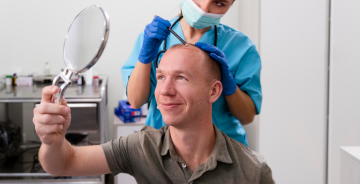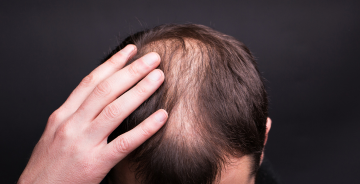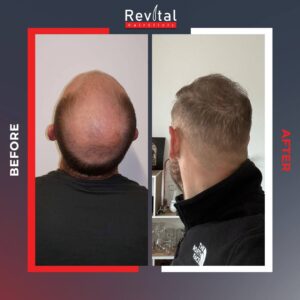Category Blog
30 Sep
Is there an age limit for hair transplantation?
Is There an Age Limit for Hair Transplantation? Hair transplantation has become a popular solution for individuals experiencing hair loss or thinning. With its ability to restore a natural-looking hairline, a hair transplant can boost self-confidence and overall appearance. However, many people wonder if there is an age limit for undergoing this procedure. In this article, we will discuss the factors that determine whether you are a suitable candidate for a hair transplant based on your age, and explain the conditions under which the procedure can be effective. Age and Hair Transplantation: What You Need to Know While there is no strict “age limit” for hair transplantation, the suitability of the procedure depends on several factors related to your age, overall health, and the extent of your hair loss. Below, we will explore the key considerations regarding age and hair transplantation. Young Patients (Under 25) For individuals under 25, hair transplantation can be a viable option, but there are certain precautions to consider: Hair Loss Pattern: In younger patients, the progression of hair loss is often unpredictable. If someone is experiencing hair loss at a young age, it’s important for the surgeon to assess whether the hair loss pattern is stable or if it’s likely to progress in the coming years. Performing a transplant too early, when hair loss is still ongoing, may lead to an unnatural result over time. Hairline Design: Younger patients tend to have a more aggressive hairline design, which can lead to complications later if the hair loss continues. Surgeons often recommend waiting until the patient’s hair loss pattern becomes more stable to ensure a more natural result in the long term. Pre-Transplant Evaluation: Before proceeding with a transplant, a thorough consultation and hair analysis are essential. Surgeons may suggest non-surgical options, like PRP therapy or medication, to stabilize hair loss before committing to a transplant. Middle-Aged Patients (25–50) For patients aged between 25 and 50, hair transplantation is typically highly effective. During this period: Stable Hair Loss: By this age, hair loss tends to stabilize, meaning the patient’s hair loss pattern is less likely to change drastically in the future. This makes it a suitable time for a transplant, as the results will last longer and appear more natural. Personalized Treatment Plans: Surgeons can design a natural-looking hairline based on the patient’s facial structure and existing hair loss. In many cases, hair transplants are used to restore hairlines or thicken thinning areas without needing to make major adjustments in the future. Advanced Techniques: Patients in this age group are usually suitable candidates for advanced hair transplant techniques such as FUE (Follicular Unit Extraction) or DHI (Direct Hair Implantation), which offer minimal scarring, faster recovery times, and more precise results. Older Patients (50 and Above) For patients over 50 years old, hair transplantation is still a viable option, but there are additional considerations: General Health: Older patients must be in good overall health to undergo surgery. Health conditions such as heart disease, diabetes, or high blood pressure can affect the success of the procedure and the recovery process. Before proceeding, a thorough medical examination is crucial to ensure the patient is fit for surgery. Donor Area Quality: The success of a hair transplant depends heavily on the quality and density of the donor area (the back and sides of the scalp). As individuals age, hair in the donor area may become thinner or weaker, which can limit the number of follicles available for transplantation. However, many older patients still have adequate donor hair, making the transplant effective. Realistic Expectations: Older patients may have a more mature hairline due to age-related hair thinning. It’s essential to set realistic expectations, as the transplant will likely focus on restoring density and improving hairline aesthetics rather than reversing the effects of aging completely. Hair Loss Stability: Like middle-aged patients, older individuals typically have a more stable hair loss pattern, meaning the transplanted hair is unlikely to be affected by further thinning or receding. ⚕️ The Role of Health and Medical Conditions While age is a significant factor, your overall health and medical conditions play an even more crucial role in determining whether you’re a suitable candidate for hair transplantation. Regardless of your age, it’s important to be in good physical condition to undergo surgery. Some of the conditions that may affect eligibility include: Chronic diseases (e.g., heart disease, diabetes, autoimmune disorders) Blood circulation problems or clotting disorders Scalp conditions such as psoriasis or fungal infections In these cases, it’s important to address any health issues before proceeding with the transplant. Your surgeon will work with your healthcare provider to determine whether the procedure is safe for you. Is Age the Only Factor? While age plays a significant role, it is not the only factor that determines whether you are a good candidate for hair transplantation. Other considerations include: Extent of hair loss: The more advanced your hair loss, the more challenging it may be to restore a natural result. In some cases, patients with severe hair loss may require more grafts, which can affect the outcome. Hair type and quality: The texture, density, and overall quality of your hair will influence the final result. Individuals with thicker hair tend to have more successful outcomes as transplanted hair blends more easily with existing hair. Hairline design preferences: Your expectations and goals for the new hairline will be considered in the planning process. A skilled surgeon will ensure that your hair transplant is customized to your facial features, age, and desired aesthetic. ⏳ What Happens if You Are Too Young or Too Old for Hair Transplantation? If you are considered too young or not yet an ideal candidate for a hair transplant, alternative treatments may be suggested, including: Hair growth medications such as minoxidil or finasteride, which can help slow hair loss and promote regrowth. Platelet-Rich Plasma (PRP) therapy, which uses your own blood to stimulate hair follicles and improve hair thickness. Laser therapy or scalp micropigmentation for improving hair density
READ MORE30 Sep
Who Can Have a Hair Transplant?
Who Can Have a Hair Transplant? Hair transplantation is an increasingly popular procedure for individuals experiencing hair loss or thinning. If you’re considering a hair transplant, you might be wondering: Am I a suitable candidate for this treatment? The good news is that most people with certain types of hair loss are eligible for a hair transplant, but there are specific criteria that determine who is a good candidate. In this article, we’ll explore who can have a hair transplant, the factors that influence eligibility, and the different conditions that can make someone a suitable candidate for this life-changing procedure. Who is a Suitable Candidate for Hair Transplantation? There are several key factors that determine whether you are a good candidate for hair transplantation. The ideal candidate will meet certain criteria related to age, gender, health, hair type, and the extent of hair loss. Age Considerations While age is not a strict barrier to undergoing a hair transplant, it plays an important role in determining your suitability. Most hair transplant surgeons recommend that candidates be at least 25 years old before considering the procedure. Here’s why: Stable Hair Loss: Younger individuals may still be experiencing ongoing hair loss, which can result in a transplant that does not look natural as hair loss progresses. Surgeons typically wait until the hair loss pattern stabilizes before performing the procedure. Pattern of Hair Loss: For patients under 25, surgeons often prefer to evaluate whether the hair loss is likely to stabilize or if it may continue. If hair loss is still actively progressing, transplanting hair prematurely may lead to uneven results in the future. In patients aged 25–50, hair loss is usually stable, making this age range ideal for transplantation. For individuals over 50, age is less of a concern as long as they are in good health and have a sufficient amount of donor hair. Extent of Hair Loss The amount of hair loss you have is an important factor in determining whether you are a suitable candidate. Hair transplant procedures work best when the pattern of hair loss is well-defined and not too advanced. Early Stage Hair Loss: If your hair loss is in the early stages and you’re experiencing receding hairlines or thinning at the crown, you’re likely a great candidate for a transplant. Advanced Hair Loss: Individuals with more advanced hair loss or bald spots may still be eligible for a transplant, but the procedure might require more grafts and could take longer to achieve a full restoration. Surgeons use Norwood and Ludwig scales to assess the level of male and female hair loss, respectively. If you’re at an early or moderate stage, you’re more likely to get satisfactory results. Health Condition Your overall health is crucial when determining if you’re a good candidate for a hair transplant. The procedure is a surgical one, and like any surgery, it requires that the patient be in good physical condition. Specific health conditions or factors that may affect eligibility include: Chronic Illnesses: Conditions like diabetes, heart disease, or autoimmune disorders can complicate the surgery or healing process. Medications: Certain medications (such as blood thinners) or ongoing treatments might interfere with the healing process or affect the success of the transplant. Scalp Health: You should have a healthy scalp free from conditions such as severe dandruff, fungal infections, or scalp psoriasis. These conditions can interfere with the procedure or affect the health of the transplanted hair follicles. Before moving forward with the procedure, a medical examination is often required to ensure that you’re fit for surgery. Hair Type and Quality The type and quality of your hair plays a role in determining the success of a hair transplant. People with thick, coarse hair tend to have the best outcomes because the transplanted hair blends more easily with existing hair. Here’s how hair type can affect the procedure: Thick, Coarse Hair: This type of hair allows for more coverage and a denser result after the transplant. It can create a fuller, more natural-looking hairline. Thin, Fine Hair: People with fine hair may still be suitable candidates for a transplant, but they might need more grafts to achieve the same density as individuals with thicker hair. The final results may not appear as dense as those with coarser hair. It’s important to note that the quality of the donor hair (usually from the back or sides of the scalp) will also play a crucial role in the success of the transplant. Healthy, dense donor hair is essential for optimal results. Realistic Expectations A good candidate for hair transplantation is someone who has realistic expectations about the results. Hair transplants can restore hairlines and add density, but they can’t completely reverse the effects of aging or hair loss. Expectations should be in line with what’s achievable based on the amount of donor hair available and the extent of the hair loss. Before the procedure, a detailed consultation with the surgeon is essential. The surgeon will evaluate your current hair loss, discuss the options, and set realistic goals for the surgery. ⚕️ Who Should Not Have a Hair Transplant? While many individuals are suitable candidates for hair transplantation, some people might not be ideal candidates. Here are some situations where a hair transplant may not be appropriate: Youth Under 25: As mentioned earlier, young individuals under the age of 25 may not be good candidates if their hair loss is still active or not fully stabilized. Insufficient Donor Hair: If you have little or no hair in the donor area (the back or sides of the scalp), there may not be enough hair to transplant. In these cases, alternative solutions, such as synthetic hair transplants or scalp micropigmentation, may be recommended. Severe Health Issues: Individuals with chronic diseases, active infections, or certain medical conditions may not be eligible for surgery until their health improves or is stabilized. Scalp Conditions: Individuals with scalp infections, severe dandruff, or other scalp disorders may need to address these issues before
READ MORE30 Sep
When is hair transplantation performed?
When is Hair Transplantation Performed? Hair transplantation is a life-changing procedure for individuals suffering from hair loss or thinning. Whether due to genetics, aging, or other factors, hair loss can affect self-esteem and confidence. Many people turn to hair transplants as a long-term solution to restore their natural hairline and density. However, the timing of when hair transplantation is performed is an important aspect to consider. In this article, we will explore the factors that determine when hair transplantation is performed and why timing plays a crucial role in achieving the best results. When is Hair Transplantation the Right Option? The decision to undergo hair transplantation is often influenced by various factors such as the stage of hair loss, overall health, and personal preferences. Here are some common scenarios when hair transplantation is typically performed: When Hair Loss Reaches a Stable Stage Hair transplantation is usually performed when hair loss has stabilized. If hair loss is ongoing, transplanting hair prematurely may lead to unsatisfactory results as hair loss continues in untreated areas. It is essential that the patient’s hair loss pattern has slowed down or become more predictable over time. For Younger Individuals (Under 25): Surgeons typically prefer to wait until hair loss has slowed and stabilized. Hair loss in individuals under 25 is often still progressing, which can result in an unnatural outcome if a transplant is performed too early. For Middle-Aged Individuals (25–50): Hair loss tends to stabilize during this age range, making it an ideal time for a hair transplant. Surgeons can assess the pattern of hair loss and design a transplant plan based on the patient’s stable hair condition. For Older Individuals (50 and Above): While age is less of a concern, the overall health of the patient must be considered. In older individuals, hair loss tends to stabilize, and the procedure can restore density without major changes in the hairline. When Other Treatments Have Not Been Effective Before deciding to undergo a hair transplant, many individuals try other hair loss treatments, such as medication (e.g., Minoxidil or Finasteride), PRP therapy (Platelet-Rich Plasma), or low-level laser therapy. If these treatments do not provide satisfactory results or hair loss continues, a hair transplant may be considered as a more permanent solution. For patients who have tried medical treatments without success, hair transplantation may be the best option to restore a natural hairline. Combination Treatment: In some cases, hair transplantation is performed alongside other treatments like PRP to enhance the overall results and promote hair growth in the transplanted areas. When Sufficient Donor Hair is Available Hair transplantation is based on the availability of healthy donor hair, typically from the back or sides of the scalp. The donor area must have enough density and good-quality hair to be used for transplantation. If a patient has insufficient donor hair, the transplant may not be feasible, or additional options like body hair transplant or artificial hair might be considered. Donor hair density is crucial, as an insufficient number of follicles can lead to unsatisfactory coverage after the transplant. Hair Type: Patients with thicker, denser hair generally achieve better results as the transplanted hair integrates more naturally with existing hair. When the Hair Loss Pattern is Defined The best time to perform a hair transplant is when the pattern of hair loss is well-established. If the hair loss is unpredictable or too severe, it may be difficult to design a natural-looking hairline. Men with Male Pattern Baldness (MPB): For men, especially those with male pattern baldness, a hair transplant is often performed once the bald areas are clearly defined and there is enough donor hair to cover these areas. Women with Female Pattern Baldness (FPB): Women who suffer from thinning hair or female pattern baldness often choose a hair transplant once they notice areas of thinning that are stable and have sufficient donor hair. When the Patient Has Realistic Expectations Hair transplantation is a cosmetic procedure, and patients must have realistic expectations about the outcome. Hair transplants can restore hairlines, improve density, and reverse some effects of hair loss, but they do not completely reverse the aging process or fix all hair loss issues. Consultation and Assessment: A thorough consultation with a hair transplant surgeon is crucial to evaluate the degree of hair loss, hair type, and desired results. The surgeon can explain the limitations and set achievable goals based on the patient’s unique situation. Long-Term Planning: Patients should be prepared for the possibility of needing future treatments or procedures, as hair loss can continue even after a successful transplant. ⚕️ Why Timing is Important in Hair Transplantation The timing of hair transplantation plays a significant role in the quality of the results. Here’s why: Hair Growth Cycle: Hair transplants are based on the natural hair growth cycle, which includes the anagen (growth), catagen (resting), and telogen (shedding) phases. Understanding this cycle ensures that hair follicles are transplanted at the right stage for optimal growth and survival. Avoiding Future Hair Loss: Performing a transplant too early may result in future hair loss in untreated areas, which can affect the appearance of the overall result. A properly timed transplant ensures that the transplanted hair blends naturally with the surrounding hair as it grows. Long-Term Hairline Design: A skilled surgeon can design a hairline that complements the patient’s facial features and accommodates potential future hair loss, creating a more permanent and natural result. When Should a Hair Transplant Not Be Performed? While most people are eligible for a hair transplant, there are certain circumstances when a transplant may not be recommended: Active Scalp Infections or Disorders: If a patient has scalp conditions such as severe dandruff, fungal infections, or psoriasis, the transplant may need to be postponed until the condition is treated and the scalp is healthy. Severe Health Issues: Individuals with chronic health conditions or who are not in good overall health may need to delay the procedure. A thorough medical examination is necessary to ensure that the patient is fit
READ MORE30 Sep
What is hair transplantation?
What is Hair Transplantation? Hair transplantation is a surgical procedure that involves transferring hair follicles from one part of the body (typically the back or sides of the scalp) to areas that are thinning or bald. This technique provides a permanent solution to hair loss, especially for individuals suffering from male or female pattern baldness, alopecia, or scarring. In this article, we will dive deep into what hair transplantation is, the different techniques used, the benefits of the procedure, and what you can expect before, during, and after the treatment. What Exactly is Hair Transplantation? Hair transplantation is a cosmetic procedure aimed at restoring lost hair in areas of the scalp or body where hair has thinned or disappeared. The goal is to provide a natural, fuller head of hair that grows permanently. The process involves: Harvesting healthy hair follicles from a donor area (usually the back or sides of the head where hair growth is dense and stable). Transplanting those follicles into areas that are thinning or completely bald. This method is beneficial for individuals who have lost hair due to: Genetics (male or female pattern baldness) Trauma or injury (scarring from accidents) Alopecia (autoimmune-related hair loss) Other medical conditions that result in hair loss. ⚕️ How is Hair Transplantation Performed? There are two primary techniques for hair transplantation: FUE (Follicular Unit Extraction) and FUT (Follicular Unit Transplantation). Both methods have their pros and cons, and the best choice depends on your individual needs, hair loss pattern, and the recommendations of the surgeon. FUE (Follicular Unit Extraction) FUE is one of the most popular and advanced techniques for hair transplantation. It involves the following steps: Individual Follicles Removal: Using a tiny, circular punch, the surgeon extracts individual hair follicles from the donor area. Preparation and Implantation: The follicles are then prepared and transplanted into tiny incisions made in the recipient area. Advantages of FUE: Minimal scarring Faster recovery time No need for stitches Natural-looking results FUT (Follicular Unit Transplantation) FUT is an older technique but still widely used. It involves: Strip Harvesting: The surgeon removes a thin strip of skin with hair follicles from the donor area (typically the back of the scalp). Dissecting and Implanting Follicles: The strip is then divided into individual follicular units, which are implanted into the thinning or balding areas. Advantages of FUT: Can transplant a larger number of hair follicles in a single session. It may be more cost-effective than FUE in some cases. Disadvantages of FUT: Linear scar in the donor area. Longer recovery time. DHI (Direct Hair Implantation) DHI is an advanced form of FUE where hair follicles are implanted directly into the recipient area using a specialized tool called the Choi Implanter Pen. The technique allows for more precise and denser placement of hair follicles. Advantages of DHI: Minimal scarring More precise follicle implantation Faster healing process Who is a Good Candidate for Hair Transplantation? Not everyone is a suitable candidate for hair transplantation. Ideal candidates are typically those who: Have stable hair loss (i.e., the hair loss has stopped or slowed down). Have sufficient donor hair on the scalp, which can be used for the transplant. Are in good overall health and have no serious medical conditions that would hinder the healing process. Have realistic expectations regarding the results. While most people with male or female pattern baldness are suitable candidates, other conditions such as scarring alopecia or hair loss due to trauma can also be treated with hair transplantation. What Happens Before, During, and After the Procedure? Before the Procedure: Consultation: The process starts with a thorough consultation with a hair transplant surgeon. During this consultation, the surgeon will assess your hair loss, discuss your goals, and design a treatment plan that suits your specific needs. Pre-Operative Instructions: You will be given guidelines to follow before the procedure, such as avoiding certain medications, alcohol, or smoking. During the Procedure: Anesthesia: The procedure is typically performed under local anesthesia, meaning you will be awake during the surgery but won’t feel pain in the treated areas. Harvesting Hair Follicles: The surgeon will extract hair follicles from the donor area (using either the FUE or FUT method). Implantation: The harvested follicles will be implanted into small incisions made in the balding or thinning areas of your scalp. After the Procedure: Recovery Time: The recovery period for a hair transplant varies, but most patients can return to work after about 3-7 days, depending on the technique used. Post-Operative Care: You will need to follow post-procedure care instructions carefully. This includes avoiding heavy physical activities, protecting your scalp from sun exposure, and using prescribed medications or shampoos. Hair Growth Timeline: New hair growth typically begins around 3-4 months post-procedure. The full results may take 12-18 months to fully appear, as the transplanted follicles need time to establish themselves and begin growing new hair. Benefits of Hair Transplantation Hair transplantation offers numerous advantages over other hair loss treatments, such as medications or hairpieces. Some of the benefits include: Permanent Results: The transplanted hair is resistant to the hormonal factors that cause hair loss, ensuring long-lasting and permanent results. Natural-Looking Hairline: When performed by an experienced surgeon, hair transplants can create a natural, fuller-looking hairline that blends seamlessly with your existing hair. Boost in Confidence: Restoring your hairline and hair density can significantly boost self-esteem and confidence, improving your overall quality of life. No Need for Ongoing Maintenance: Unlike treatments like medications, hair transplants don’t require ongoing maintenance or repeat procedures once the hair is successfully transplanted. In Conclusion Hair transplantation is an advanced, permanent solution for hair loss that can restore both the appearance and self-confidence of those experiencing thinning or baldness. By moving healthy hair follicles from the donor area to the areas of the scalp that are thinning or bald, a hair transplant can provide natural, permanent results. At Revital Hair Clinic, we specialize in various hair transplantation methods, such as FUE, FUT, and DHI, to offer you the best
READ MORERevital Hair Clinic © 2024















